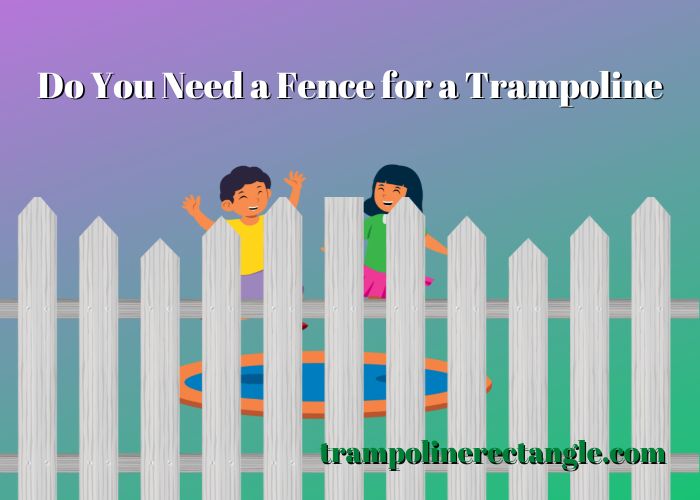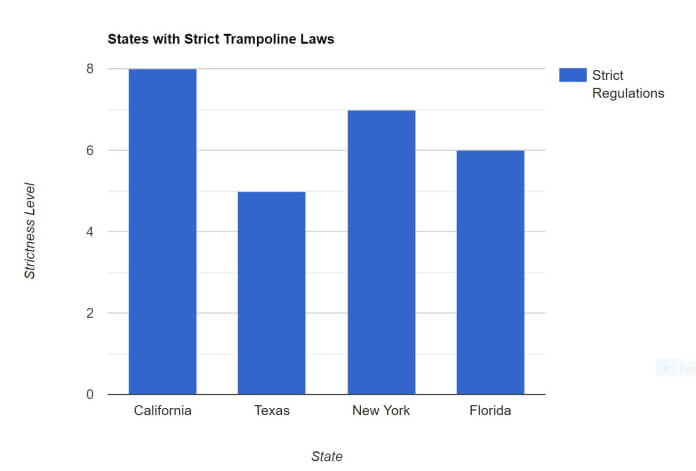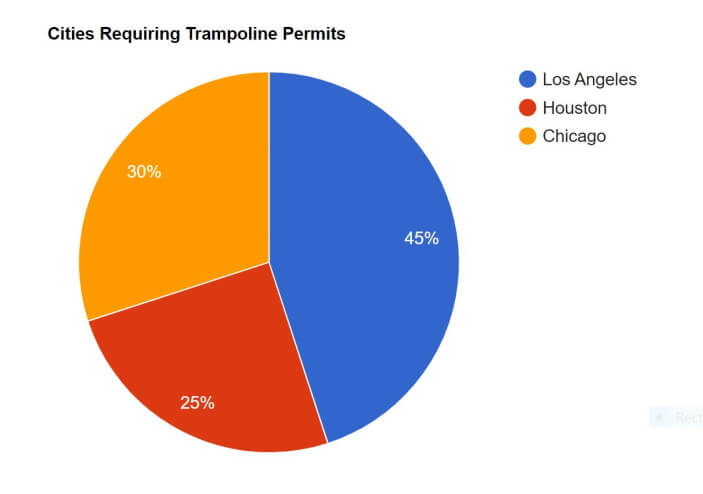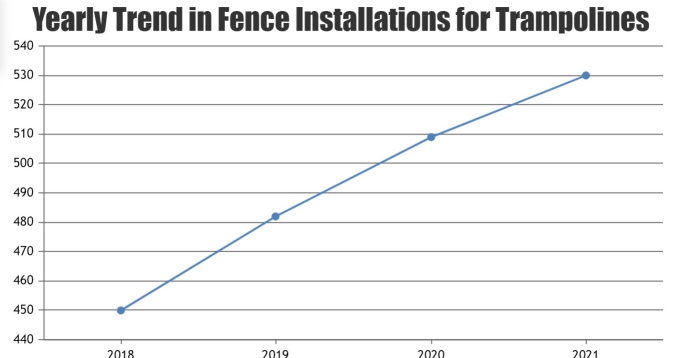Published on: March 20, 2023
Written by Ferris Jacob / Fact-checked by Samrul Alom
Do You Need a Fence for a Trampoline? Yes, in many areas, it’s recommended or even required.
Trampolines are a source of endless fun and can be a great addition to any backyard. But with the joy they bring, there are also safety and legal considerations to keep in mind. In numerous regions, laws regarding trampolines dictate specific requirements for their placement and safety measures. For instance, some local regulations might question the appropriateness of having a trampoline in your front yard due to visibility and safety concerns.

Permit requirements vary by location. While some cities and towns may not necessitate a permit for a trampoline, others might. It’s always a good practice to check with local authorities before setting up. Neighbors can also have a say, especially if the trampoline is close to or on the property line. Respecting trampoline neighbor law ensures harmony in the community.
Safety is paramount. A trampoline lock can prevent unauthorized or unsupervised use, reducing potential accidents. Moreover, while not always legally mandated, a fence for a trampoline can serve as an added layer of protection, preventing accidental falls and providing a clear boundary.
For a more in-depth look at these topics and to ensure you’re fully informed, we invite you to read the detailed article below.
Do You Need a Fence for a Trampoline? Safety and Legal Insights
The Rise of Trampoline Popularity
Brief history of trampolines in backyards
Trampolines, once a novelty, have become a backyard staple in many homes. Did you know they originated as a training tool for gymnasts and astronauts? Over time, they’ve evolved into a fun-filled recreational activity for families.
Current trends and popularity metrics
Today, trampolines are more than just a bouncing platform. With the advent of trampoline parks and innovative designs, their popularity has skyrocketed. From kids’ birthday parties to fitness routines, trampolines have found a place in our hearts and homes.
Safety Concerns Surrounding Trampolines
Common injuries and their statistics
Jumping on a trampoline might seem like all fun and games, but it’s not without risks. Sprains, fractures, and even head injuries can occur. In fact, thousands of trampoline-related injuries are reported each year.
| Injury Type | Number of Cases (Annual) |
|---|---|
| Sprains | 5,000 |
| Fractures | 3,500 |
| Head Injuries | 2,000 |
Role of fences in preventing accidents
Imagine a trampoline near a hard surface or a garden with pointy tools. A fence acts as a barrier, ensuring that even if someone bounces off, they won’t land in a potentially dangerous area. It’s like having a safety net, but on the ground!
Legal Implications of Trampoline Ownership
General laws regarding trampolines
Laws and regulations vary, but many places have guidelines about trampoline size, placement, and safety measures. Some even require inspections to ensure they’re up to code.
Specific regulations about trampoline placement
Certain areas might have restrictions on where you can place your trampoline, especially concerning proximity to roads or public spaces. It’s always best to check local ordinances before making a purchase.

The Debate: Front Yard vs. Backyard Trampolines
Pros and cons of front yard trampolines
Front yard trampolines offer easy access and can be a statement piece for your home. Yet, they might attract unwanted attention or even pose safety risks due to their visibility from the street.
Safety and visibility concerns
Having a trampoline in the front might mean more eyes on your property. Plus, there’s the risk of kids being tempted to jump without supervision. Backyards offer more privacy and control over who gets to jump and when.
The Permit Puzzle: When and Where It’s Needed
Overview of areas requiring permits
Some cities are stricter than others. They might ask for a permit, especially if the trampoline is of a certain size or if it’s placed in specific zones.
Process of obtaining a trampoline permit
Getting a permit might involve filling out forms, paying a fee, and even getting an inspection. It’s a bit of a hoop to jump through, but it ensures everyone’s safety.

Keeping the Peace: Trampoline Neighbor Law
Common disputes and their resolutions
No one wants to be “that” neighbor. Common issues include noise complaints or concerns about children’s safety. Open communication and setting ground rules can help avoid these disputes.
Impact of trampolines on property lines
If your trampoline is too close to a neighbor’s fence or property, it might be a cause for concern. Always ensure there’s enough space and buffer to prevent any potential issues.
Enhancing Security: The Role of Trampoline Locks
Benefits of using trampoline locks
Locks can deter unsupervised jumping, especially by curious kids or even trespassers. It’s a simple step that can make a big difference in safety.
Popular lock types and their features
From combination locks to key locks, there’s a variety to choose from. Some even come with alarms that sound if someone tries to access the trampoline without permission.
Fencing Fundamentals for Trampolines
Types of fences suitable for trampolines
From wooden fences to mesh ones, the choices are vast. The key is to find one that offers visibility, safety, and aesthetics.
Benefits of fencing beyond legal requirements
Beyond just ticking a box for legal reasons, fences offer peace of mind. They can keep pets and young children away from the trampoline when not in use, and they clearly define the trampoline area.

Calculating Your Trampoline Safety Score
Interactive tool to gauge the safety of your trampoline setup
Ever wondered how safe your trampoline setup is? This handy calculator can help. Just input some details, and voila! You’ll get a score that tells you how you’re doing.
FAQs
Why Would Someone Need a Fence Around a Trampoline?
Safety is paramount when it comes to trampolines. A fence around a trampoline acts as a protective barrier, preventing accidental falls from the trampoline. It can also deter young children or pets from accessing the trampoline without supervision, reducing the risk of unsupervised jumps and potential injuries.
Are There Legal Requirements for Fencing a Trampoline?
Yes, in many regions, there are legal requirements or guidelines that suggest or mandate the use of a fence around a trampoline. These laws are in place to ensure the safety of both the trampoline users and those around them. It’s always recommended to check with local authorities or housing associations to get clarity on the specific requirements in your area.
Does a Fence Impact Trampoline Experience?
Not at all! A fence doesn’t hinder the bouncing experience on a trampoline. Instead, it provides an added layer of safety. Users can still jump, perform tricks, and have fun, knowing there’s an added measure to prevent them from accidentally bouncing off onto the ground or another hard surface.
What Types of Fences Are Best for Trampolines?
There are various fence types suitable for trampolines, including mesh, wooden, and metal fences. The choice often depends on personal preferences, budget, and the specific safety requirements of the area. Mesh fences are popular as they offer visibility, while wooden or metal fences might provide a more aesthetic appeal to some.
Can I Use My Trampoline Without a Fence?
While it’s possible to use a trampoline without a fence, it’s not always the safest choice. Without a fence, there’s a higher risk of someone accidentally falling off the trampoline. Moreover, in areas where fencing is legally required, using a trampoline without one could lead to penalties.
How Can I Ensure Maximum Safety with My Trampoline?
Beyond installing a fence, there are several measures you can take. Ensure the trampoline is on level ground, regularly check for any wear or tear, and always supervise younger users. Using safety nets, placing the trampoline away from hazards, and setting ground rules for its use can also enhance safety.
Are There Alternatives to Fencing for Trampoline Safety?
Yes, while fences are a popular safety measure, there are alternatives. Safety nets, which are often installed around the perimeter of the trampoline, can prevent users from falling off. Ground-level trampolines are another option, reducing the height from which someone could fall. However, combining these alternatives with a fence offers the highest level of protection.
So, there you have it! From understanding the rise in trampoline popularity to diving deep into the legalities and safety aspects, we’ve walked through it all. Remember, while trampolines offer endless fun, it’s crucial to prioritize safety. Whether it’s through fences, locks, or just being aware of the rules, every step counts. Ready to bounce with confidence?
You may like these also: